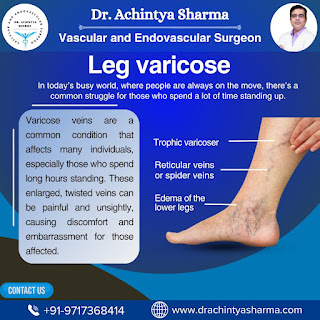Understanding Varicose Veins: Symptoms and Signs
What Are Varicose Veins?
Varicose veins develop when the valves within veins malfunction, causing blood to pool and veins to enlarge. This condition can lead to discomfort and, in severe cases, more serious health issues.
Primary Symptoms of Varicose Veins
Aching Legs: Individuals with varicose veins often experience a persistent, dull ache in their legs. This pain, one of the varicose veins symptoms, may intensify after prolonged periods of standing or sitting.
Aching Legs: Individuals with varicose veins often experience a persistent, dull ache in their legs. This pain, one of the varicose veins symptoms, may intensify after prolonged periods of standing or sitting.
Swelling: Swelling in the lower legs, ankles, and feet is a common varicose veins symptom. This occurs due to increased pressure in the veins, causing fluid to leak into surrounding tissues.
Heavy Legs: Many people report a sensation of heaviness or fatigue in their legs, especially after physical activity or long periods of immobility. This is another one of the varicose veins symptoms.
Itching and Irritation: The skin around varicose veins can become itchy and irritated. This symptom is often a result of increased pressure and poor circulation, both common varicose veins symptoms.
Muscle Cramps: Nighttime leg cramps are a frequent complaint among those with varicose veins. These cramps can disrupt sleep and lead to discomfort, marking another of the varicose veins symptoms.
Advanced Symptoms and Complications
While the aforementioned varicose veins symptoms are common, more severe cases can lead to additional complications.
Skin Changes: Chronic varicose veins can cause skin discoloration, often a brownish or bluish hue. This is known as hyperpigmentation and results from prolonged pressure and poor circulation, advanced varicose veins symptoms.
Ulcers: In severe cases, ulcers can form around varicose veins, particularly near the ankles. These ulcers are painful, slow to heal, and prone to infection, representing severe varicose veins symptoms.
Bleeding: Varicose veins close to the skin’s surface can sometimes burst, leading to minor bleeding. This usually occurs due to minor trauma or scratching, another severe varicose veins symptom.
Blood Clots: Deep vein thrombosis (DVT) is a serious complication where blood clots form in deeper veins. Symptoms include sudden swelling, redness, and severe pain in the affected limb, severe varicose veins symptoms.
Risk Factors
Certain factors increase the likelihood of developing varicose veins, including:
- Age: The risk of varicose veins increases with age, as veins lose elasticity and valves weaken over time. This contributes to the development of varicose veins symptoms
- Gender: Women are more prone to varicose veins due to hormonal changes during pregnancy, menstruation, and menopause. Hormonal treatments, such as birth control pills, may also elevate risk, leading to varicose veins symptoms.
- Genetics: A family history of varicose veins significantly increases the risk, indicating a genetic predisposition to the condition and its symptoms.
- Obesity: Excess body weight places additional pressure on veins, contributing to their development and worsening varicose veins symptoms.
- Prolonged Standing or Sitting: Occupations that require long periods of standing or sitting can hinder blood flow, increasing the likelihood of varicose veins and related symptoms.
- Pregnancy: The increased blood volume during pregnancy, along with hormonal changes, can lead to the development of varicose veins. Additionally, the pressure from the growing uterus can affect leg veins, causing varicose veins symptoms.
Preventive Measures and Management
While varicose veins cannot always be prevented, certain lifestyle changes can help manage symptoms and reduce the risk of developing them:
- Exercise Regularly: Engaging in physical activities like walking, swimming, or cycling can improve circulation and strengthen leg muscles, helping to alleviate varicose veins symptoms.
- Maintain a Healthy Weight: Keeping a healthy weight reduces pressure on veins, helping to prevent varicose veins or manage existing symptoms.
- Elevate Your Legs: Elevating legs above heart level can reduce swelling and improve blood flow. Aim to do this several times a day, especially after prolonged periods of standing or sitting, to mitigate varicose veins symptoms
- Avoid Tight Clothing: Tight clothing, particularly around the waist, legs, and groined, can restrict blood flow and contribute to varicose veins and symptoms.
- Wear Compression Stockings: These specialized stockings apply gentle pressure to the legs, promoting blood flow and reducing swelling, alleviating varicose veins symptoms.
- Move Frequently: If your job requires long periods of standing or sitting, take regular breaks to move around and encourage blood flow, preventing varicose veins symptoms.
Conclusion
Recognizing the varicose veins symptoms is essential for early intervention and management. While varicose veins can be uncomfortable and unsightly, various treatments and lifestyle adjustments can alleviate symptoms and improve quality of life. If you suspect you have varicose veins or are experiencing severe symptoms, consult a healthcare professional for a comprehensive evaluation and personalized treatment plan. By understanding and addressing the varicose veins symptoms, you can take proactive steps to maintain your vascular health.






.jpg)
Comments
Post a Comment